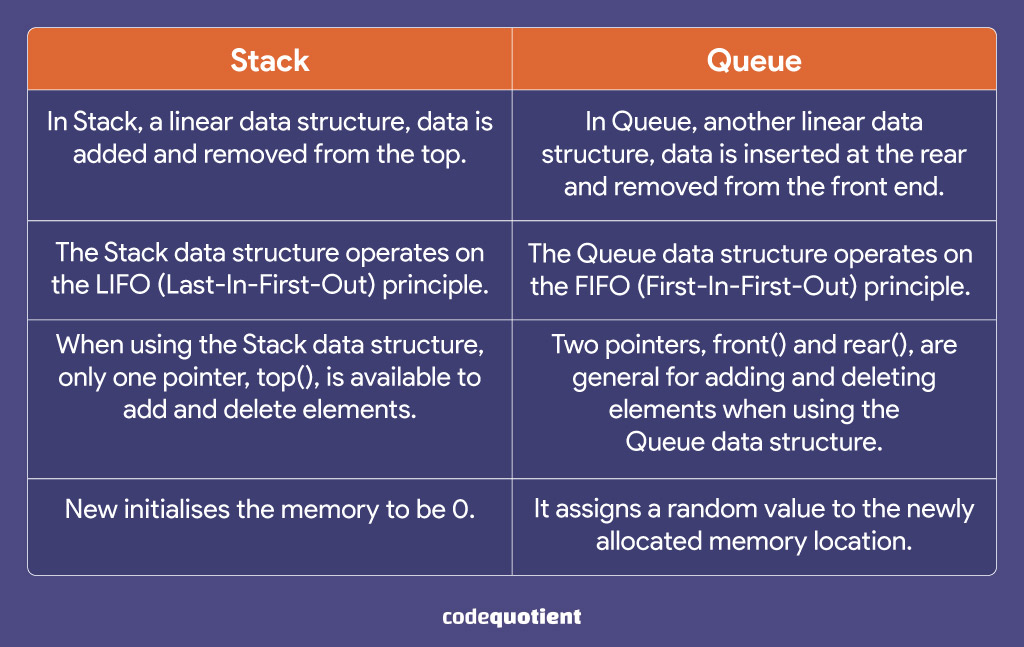Data Structures and Algorithms (DSA) are the backbones of software development. A firm grasp of these concepts is essential for success in the field. Whether you’re aspiring to become a programmer or data scientist, especially in big tech companies, DSA is a must-know topic.
To excel in a DSA interview, it’s crucial to prepare thoroughly. This preparation should begin with studying typically asked questions.
In this blog post, we have compiled the 9 fundamental Data Structures and Algorithms interview questions that interviewers typically ask, particularly for beginners. For your convenience, we have also included answers to these questions.
So, let’s dive in and explore these questions together.
Data Structures and Algorithms Interview Questions for Beginners
1. What is a data structure?
A data structure is a way to organise and store data in a computer’s memory to be accessed and used efficiently.
2. What is an algorithm?
An algorithm is a set of instructions that describe how to perform a specific task or solve a problem.
3. What are the different types of data structures?
Linear Data Structure:
A structure where data elements are arranged sequentially or linearly, and each element is connected to its previous and next nearest elements.
Some examples of linear data structures:
- Arrays: a collection of elements of the same data type that can be accessed using an index.
- Linked lists: a collection of nodes containing a data element and a reference to the next node in the list.
- Stacks: a collection of elements that supports two basic operations: push and pop.
- Queues: a group of elements that supports two basic operations: enqueue and dequeue.
Non-Linear Data Structure:
This type of structure is where data elements are not arranged linearly or sequentially. Unlike a linear data structure, traversing all aspects in a single pass in a non-linear data structure is almost impossible.
Few examples of non-linear data structures:
- Trees: a collection of nodes connected by edges, with a root node at the top and leaf nodes at the bottom.
- Graphs: A set of edges that connect vertices forms a graph.
4. What is a stack data structure? What are the applications of a stack?
A stack is a linear data structure storing elements in a Last-In-First-Out (LIFO) manner. It has two primary operations: push (add an element to the top) and pop (remove an element from the top of the stack).
The applications of a stack are:
- Reversing a string
- Checking for balanced parentheses
- Implementing function calls and returns
- Evaluating postfix expressions
5. What is a queue data structure? What are the applications of the queue?
A queue is a linear data structure storing elements in a First-In-First-Out (FIFO) manner. It has two primary operations: enqueue (add an element to the back of the queue) and dequeue (remove an element from the front of the queue).
The applications of a queue include:
- Implementing a print spooler,
- Breadth-first search in a graph,
- CPU scheduling
- Disk scheduling
6. What is the difference between a stack and a queue?

7. What is array data structure? What are the applications of arrays?
An array is a collection of elements of the same data type stored in contiguous memory locations. It can be one-dimensional, two-dimensional, or multi-dimensional.
The applications of arrays include:
- Storing and accessing sequential data
- Implementing other data structures such as queues, stacks, and hash tables
- Sorting and searching algorithms
- Matrices and tables
8. What is an asymptotic analysis of an algorithm?
Asymptotic analysis is a way to analyse the performance of an algorithm in terms of input size. It helps us estimate an algorithm’s running time and space complexity.
Three types of notations are used in the asymptotic analysis: Big O, Big Omega, and Big Theta. Big O notation is the most commonly used notation, representing the upper bound of the running time.
9. What is a HashMap in data structure?
A HashMap is a data structure that stores key-value pairs. It uses a hash function to calculate the index of the array where the key-value pair is stored. The key is used to calculate the hash code, which is used to find the index of the array. The value is stored at the index of the array.
Final Thoughts
Besides these data structures and algorithms interview questions, understanding the fundamentals of DSA is necessary as it allows you to demonstrate your potential as a software developer.
Whether preparing for your first interview or looking to strengthen your skills, these questions are a great place to start. So, keep practising and expanding your knowledge to unlock your potential as a developer!
The SuperCoders Program from the learning and career platform CodeQuotient is a three-month internship that enables learners to take their skills and career to the next level.
With project-based learning opportunities to create an impressive portfolio and mentorship from industry experts, this program offers various career-building benefits.
Talk to us to learn more!




